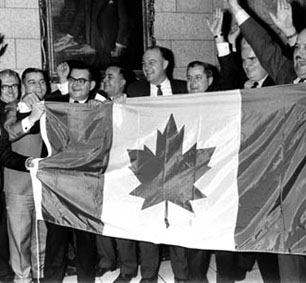The Long Journey to a Canadian Republic

MP s celebrate approval of new independent Canadian flag by a 163 to 78 vote in the Canadian House of Commons, December 15, 1964.
TUESDAY, JULY 1, 2014 [UPDATED WEDNESDAY, JULY 1, 2015, THURSDAY, SEPTEMBER 15, 2016, FRIDAY, AUGUST 11, 2017, SUNDAY, DECEMBER 23, 2018, TUESDAY, DECEMBER 31, 2019 ; THURSDAY, MARCH 18, 2021, MAY 10, 2022, MAY 11, 2023] : It’s not easy being a Canadian republican these days. Not someone who has anything to do with the Republican Party in the United States. But someone who believes that modern Canada is in practice, and ought to be in theory too, a parliamentary democratic republic — within all of the Arctic Council, APEC, ASEAN, the Commonwealth of Nations, the G7, the G20, La francophonie, NAFTA (part deux or CUSMA) , NATO, OAS, OECD, TPP, and the United Nations, etc, etc, etc, etc … world without end.
A Canadian republican is also someone who believes that Canada today ought to have no official, legal, constitutional or other lingering colonial ties to the British monarchy, if you prefer to say it that way. At the same time, like India or Ireland or Trinidad & Tobago, the new Canadian republic of anyone’s realistic dreams will continue to be modeled on the established “Westminster” or British-style parliamentary institutions of government, which have served Canada well. Ever since the European “year of revolution” in 1848 coincided with colonial “responsible government” in British North America (following the Canadian rebellions of 1837–1838).
“The Long Journey to a Canadian Republic, 1963-20??” is the title of Part IV in Randall White’s current book project, tentatively entitled Children of the Global Village : Democracy in Canada Since 1497. (One inspiration for the title and larger project has apparently been the late Bruce Trigger’s Ontario history classic of the mid 1970s, The Children of Aataentsic : A History of the Huron People to 1660. There have been several other such inspirations, including Peter B. Waite’s Canada 1874-1896 : Arduous Destiny ; An Australian Republic by Greg Barns and Anna Krawec-Wheaton ; Frederick Vaughan’s The Canadian Federalist Experiment : From Defiant Monarchy to Reluctant Republic ; and La solution : le programme du Parti québécois, présenté par René Lévesque.)
Mr. White has explained that Children of the Global Village is a work in progress, based on the following draft table of contents :
Prologue : too much geography
PART I : The Deep Canadian Past, 1497–1763
PART II : Second British North America, 1763–1867
PART III : Dominion of Canada, 1867–1963
PART IV : The Long Journey to a Canadian Republic, 1963–20??
Epilogue : the near future
Mr. White has further confessed that he has now completed Part IV on this outline. And, mirabile dictu, he has even finished an appallingly long epilogue (but with most of the length in a highly optional appendix) — completing the counterweights program of early digital publishing for parts of the book that are largely complete.
Following here, immediately below, are links to the (now all) completed draft chapters. The entire book, in draft at least, is now pre-published on this site. A final more carefully edited and source-referenced hard-copy print edition will be published by eastendbooks soon enough. Meanwhile here is what Children of the Global Village : Democracy in Canada Since 1497 looks like online, as of Spring 2023.
* * * *
For “Prologue : too much geography” CLICK HERE.
* * * *
* For Chapter 1 of PART I : THE DEEP CANADIAN PAST, 1497-1763 see “Misty contact : Giovanni Caboto and sponsor in Atlantic Canada , 1485–1689” or CLICK HERE .
* For Chapter 2 of PART I : THE DEEP CANADIAN PAST, 1497-1763 see “Indigenous peoples of Canada have given more than a name to Canadian history” or CLICK HERE.
* For Chapter 3 of PART I : THE DEEP CANADIAN PAST, 1497-1763 see “France in America and the first people who called themselves Canadians” or CLICK HERE.
* For Chapter 4 of PART I : THE DEEP CANADIAN PAST, 1497-1763 see “First Quest for the Northwest in Canada, 1615-1760” or CLICK HERE.
* For Chapter 5 of PART I : THE DEEP CANADIAN PAST, 1497-1763 see “English-speaking Canada before 1763” or CLICK HERE.
* For Chapter 6 of PART I : THE DEEP CANADIAN PAST, 1497-1763 see “Three 18th century wars that made two countries, 1754-1784” or CLICK HERE.
* * * *
* For Chapter 1 of PART II : SECOND BRITISH NORTH AMERICA, 1763—1867 see “The new northern British America in the late 18th and early 19th centuries” or CLICK HERE.
* For Chapter 2 of PART II : SECOND BRITISH NORTH AMERICA, 1763—1867 see “The beginnings of various regional democracies in what is now Canada, after the War of 1812” or CLICK HERE.
* For Chapter 3 of PART II : SECOND BRITISH NORTH AMERICA, 1763—1867 see “The Canadian boom of the 1850s and the road to Confederation, 1848—1864” or CLICK HERE.
* For Chapter 4 of PART II : SECOND BRITISH NORTH AMERICA, 1763—1867 see “The American Civil War and the British North America Act, 1867” or CLICK HERE.
* * * *
* For Chapter 1 of PART III : THE DOMINION OF CANADA, 1867—1963 see “First self-governing dominion of the British empire : Further founding moments, 1867—1873” or CLICK HERE.
* For Chapter 3 of PART III : THE DOMINION OF CANADA, 1867—1963 see “Sunny Ways : Imperial Preference, New Boom, and Last Best West, 1896—1911” or CLICK HERE.
* For Chapter 4 of PART III : THE DOMINION OF CANADA, 1867—1963 see “Our Lady of the Snows, 1911—1921” or CLICK HERE.
* For Chapter 5 of PART III : THE DOMINION OF CANADA, 1867—1963 see “Age of the Incredible Canadian, 1921—1948” or CLICK HERE.
* For Chapter 6 of PART III : THE DOMINION OF CANADA, 1867—1963 see “Democracy in the Dominions, 1948—1963” or CLICK HERE.
* * * *

